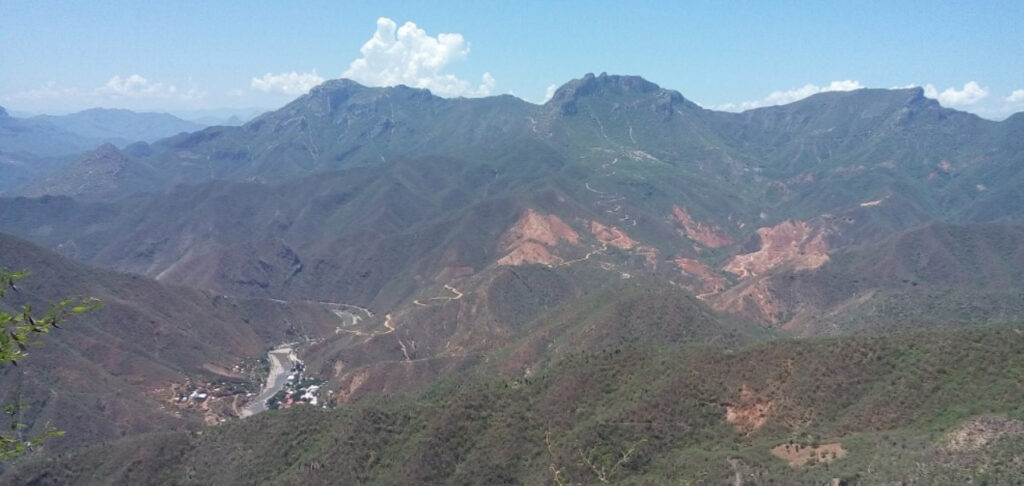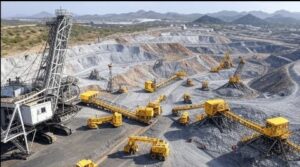Highlights include 3.65m grading 8.18 g/t Au including 1.65m grading 12.75 g/t Au
April 12, 2022 – Vancouver and Hong Kong – Reyna Silver Corp. (TSXV: RSLV; OTCQX: RSNVF; FRA: 4ZC) (“Reyna” or the “Company“) is pleased to report results from 19 holes totaling 7964 meters (m) of the 10,000-meter Stage 1 drilling program, on its 100% owned Batopilas Project in southwestern Chihuahua, Mexico. This drilling program follows up on high-grade gold values discovered during a 2021 trenching program (See press release of February 4, 2021), and subsequent high-silver and gold mineralization intersected in Hole BA21-30 (See press release of September 8, 2021).
Highlights
- A high-grade gold zone is emerging in the northeastern (NE) portion of the claim package showcased by Hole BA21-42A (See Table 1).
- The NE gold zone overlaps the southwestern (SW) native silver zone, indicating two overlapping mineralization sources (Figure 1).
- Building on the new exploration potential presented by these recent discoveries, the company immediately initiated a selective sampling survey to be followed by a detailed structural study and additional geophysics to refine drill targeting.
Table 1. Highlights from Hole BA21-42A
| Hole ID# | from (m) | to (m) | width (m) | Au (g/t) |
| BA21-42A | 179.85 | 189.20 | 9.35 | 3.38 |
| including | 180.20 | 183.85 | 3.65 | 8.18 |
| including | 182.20 | 183.85 | 1.65 | 12.75 |
“As silver explorers we came to Batopilas – historically the highest-grade Native Silver District in Mexico – to look for silver, and now we’re unexpectedly finding minable widths of high-grade gold. This new zone of parallel gold-bearing veins in the NE opens up exciting new exploration opportunities for both the gold and the silver,” said Jorge Ramiro Monroy, CEO of Reyna Silver. “Finding visible gold in core was thrilling, but to confirm the conventional assay results we had many intercepts reanalyzed by Metallic Screen Assay, which gives a more accurate result for visible gold. As expected, this showed significantly higher grades than standard methods both for key drill holes reported previously and the intercepts reported here. A good example of this is the 0.25m high-grade intercept in Hole 34, which increased from 28.7 g/t Au to 36.1 g/t Au.”
“Multiple mineralization centers showing different styles of mineralization are hallmarks of important precious-metals districts, so finding high-grade gold in addition to the historic high-grade silver is a very positive reason to take a new look at our district-scale vision,” said Dr. Peter Megaw, Chief Exploration Advisor to Reyna Silver. “We need to try to link the gold and silver centers by improving our understanding of the plumbing through a new structural study followed by some geophysics-hopefully this should open a number of new potential target areas.”
Click here to watch Jorge Ramiro Monroy and Dr. Peter Megaw talk about the recent drill results.
Building on the high-grade gold intercept found in BA21-34 in the Teodoro and Orochi vein area, additional drilling in the area focused on identifying the characteristics of the gold mineralization. Holes BA21-40 to BA21-42A intersected zones carrying visible gold surrounded by more dispersed gold mineralization associated with pyrite and amphiboles (Table 2). This is a marked divergence from the calcite-dominant veins which contained the district’s historic native silver ore.
Table 2. Drill results from the NE gold zone.
| Hole ID# | from (m) | to (m) | width (m) | Au (g/t) |
| BA21-40 | 55.15 | 56.60 | 1.45 | 6.87 |
| including | 55.15 | 55.50 | 0.35 | 11.55 |
| and | 56.30 | 56.60 | 0.30 | 18.95 |
| BA21-42A | 179.85 | 185.25 | 5.40 | 5.68 |
| including | 180.20 | 185.25 | 5.05 | 6.05 |
| including | 180.20 | 183.85 | 3.65 | 8.18 |
| including | 182.20 | 183.85 | 1.65 | 12.75 |
| and | 180.20 | 180.95 | 0.75 | 9.55 |
Based on the high-grade gold and silver mineralization cut by Hole BA21-30, the program then moved south to the Cobriza area to drill six holes (BA21-43 to BA21-49). While gold grades decreased relative to the NE zone, this area contained discrete styles of both silver and gold mineralization in proximity to one another. This leads us to believe that there are probably two mineralization centers generating different styles of mineralization.
Figure 1. Map of gold and silver zones identified during Stage 1 drilling at Batopilas. Nine holes, BA21-35 to BA21-42A and BA21-50, focused on the Teodoro and Orochi area revealed the NE Gold zone (upper right portion of the map). Six holes, BA21-43 to BA21-49, were drilled proximal to the Cobriza Native-silver vein extension (middle of the map). Four holes, BA21-51 to BA22-54, focused on the SW (bottom left of the map). BA21-55 was in the Tecario vein area (near the Porfirio Diaz Tunnel, bottom right of the map).
These newly revealed features necessitate re-evaluating existing data as well as additional ground, structural and geophysical surveys. Understanding the relationship between the two styles of mineralization could be a critical tool for ongoing exploration.
The next focus of the district-scale exploration program during Stage 1 drilling was four holes (BA21-51 to BA21-54) focused on the Zone del Cinco and Los Santos silver areas as part of the district-scale exploration plan designed to better define and understand the controls on the native silver mineralization. The last of these holes (BA22-55) was over 1 kilometer south of the Cobriza zone in the Tecario area near the historic portion of the district, and cut through a 1.8m zone of unexpectedly strong gold mineralization (Table 3). This is the most recent drill result in hand and will be part of the study to understand the relationship between the gold and silver mineralization in the district.
Table 3. Hole BA22-55 in the Tecario area
| Hole ID# | from (m) | to (m) | width (m) | Au (g/t)* | Ag (g/t) |
| BA22-55 | 274.5 | 276.3 | 1.8 | 4.06 | 7.9 |
*Please note this interval has not undergone Metallic Screen Assay yet.
Metallic Screen Assay Testing
To verify the high-grade visible native gold encountered in Hole BA21-34 and in subsequent Gold Zone holes, the technical team decided to send the samples with higher gold results for repeat analysis by Metallic Screen Assaying. On average, intervals containing significant visible gold mineralization came back higher; in contrast, some of the lower grade gold intervals from the prior survey that lacked visible gold decreased. Overall it appears that the additional testing confirms the high values and increases our confidence in the gold values.
Table 4. Highlights of changes in grades post metallic screen assay
| Hole ID# | from (m) | to (m) | width | g/t Au metallic screen assay | g/t Au standard fire assay | % change |
| BA21-34 | 65.35 | 66.00 | 0.65 | 6.91 | 5.15 | 34.17% |
| BA21-34 | 45.70 | 45.95 | 0.25 | 36.10 | 28.70 | 25.78% |
| BA21-37 | 37.90 | 38.20 | 0.30 | 0.46 | 1.78 | -74.08% |
| BA21-42 | 56.30 | 56.60 | 0.30 | 18.95 | 15.45 | 22.65% |
| BA21-41 | 38.15 | 38.35 | 0.20 | 1.39 | 1.19 | 17.30% |
| BA21-42A | 179.85 | 189.20 | 9.35 | 3.38 | 2.88 | 17.14% |
| BA21-42A | 179.85 | 185.25 | 5.40 | 5.68 | 4.82 | 17.69% |
| BA21-42A | 180.20 | 185.25 | 5.05 | 6.05 | 5.14 | 17.71% |
| BA21-42A | 180.20 | 183.85 | 3.65 | 8.18 | 6.99 | 17.12% |
| BA21-42A | 180.20 | 180.95 | 0.75 | 9.55 | 6.54 | 46.02% |
| BA21-43 | 19.50 | 20.85 | 1.35 | 0.31 | 0.51 | -39.22% |
| BA21-43 | 20.85 | 21.95 | 1.10 | 0.89 | 1.21 | -26.45% |
| BA21-43 | 19.50 | 21.95 | 2.45 | 0.57 | 0.82 | -30.80% |
| BA21-44 | 100.50 | 101.00 | 0.50 | 0.82 | 1.58 | -47.94% |
| BA21-46 | 44.10 | 45.35 | 1.25 | 5.61 | 3.51 | 59.83% |
About Batopilas
Batopilas is famous as Mexico’s highest-grade silver district, having produced an estimated 200-300 million ounces of silver from native-silver rich calcite veins averaging 200 ounces per ton silver. The native silver ore shoots occur sporadically along throughgoing structures traceable for multiple kilometers across the district. Historic mining proceeded by following these veins, often mere 1 to 2 cm calcite seams, until they opened up into 1 to 4m wide, steeply inclined shoots 30-80m wide on level and as much as 350m tall. Colonial-era mining dominantly worked downwards from the surface, while the last organized mining in the district (1879-1913) was undertaken from tunnels driven at river level beneath the colonial workings. These modern efforts were interrupted by the Mexican Revolution in 1913 long before the deeper tunnels could be driven beneath many of the colonial era workings.
Reyna Silver’s exploration program in the district is focused on tracing the known and projected native silver-bearing veins into the less explored, underexploited parts of the district using surface mapping, trenching, and satellite imagery. Reyna’s planned 10,000 meters, Stage 1 drilling campaign began in June 2021 and is ongoing.
QA/QC Statement
Reyna Silver follows industry standard procedures for diamond core drilling and sample analysis. Drilling is carried out using NQ and HQ size tooling. The drill core is cut in half using a diamond rock saw with one-half of the core then taken as a sample for analysis and the other one as a register. Sample intervals are generally from 0.2 to 2 m intervals, producing samples of between 0.6 to 10 kg. Half-core samples are delivered to the internationally certified ALS Minerals laboratory facilities in Chihuahua city where the samples are prepared. ALS has a Quality management system (ISO 17025) and Assays are completed by ALS Minerals in Canada. The samples are fire assayed for Au (Au-23) and are analyzed for Ag and multi-elements using method code ICP (ICP-41) following an aqua regia digestion. Samples showing visible gold are resubmitted to ALS for Metallic Screen Assaying. Overlimits are analyzed using an appropriate method. Multi-element geochemical standards and blanks or duplicates are inserted systematically into the drill core sampling series to monitor lab performance. The control samples are inserted every 25 samples in the case of standards, blanks, and field duplicates, and for rejects and pulps duplicates each 30 samples intercalated. Referent to the chain of custody the samples are transported from Batopilas by Reyna Silver personnel to ALS Chemex in Chihuahua City.
Qualified Person
Dr. Peter Megaw, Ph.D., C.P.G., the Company’s Chief Exploration Advisor and Qualified Person, reviewed the technical aspects of exploration projects described herein and is responsible for the design and conduct of the exploration programs and the verification and quality assurance of analytical results. Dr. Megaw is not independent as he and/or companies with which he is affiliated hold Net Smelter Royalties on the Guigui and Batopilas Projects that predate Reyna Silver acquiring them.
About Reyna Silver
Reyna Silver Corp. is a silver exploration company with a robust portfolio of silver assets in Mexico and the US. The Company was built around the Guigui and Batopilas Projects, which formed part of MAG Silver’s original IPO portfolio. It is also actively exploring the Medicine Springs project in Nevada, another CRD target. Reyna’s strategy centers around leveraging its expertise in Mexico to explore projects that have the potential for high-grade, district-scale discoveries.
Cautionary Statements
This document contains “forward-looking statements” within the meaning of applicable Canadian securities regulations. All statements other than statements of historical fact herein, including, without limitation, statements regarding exploration results and plans, and our other future plans and objectives, are forward-looking statements that involve various risks and uncertainties. Such forward-looking statements include, without limitation, our estimates of exploration investment, the scope of our exploration programs, and our expectations of ongoing administrative costs. There can be no assurance that such statements will prove to be accurate, and future events and actual results could differ materially
from those anticipated in such statements. Important factors that could cause actual results to differ materially from our expectations are disclosed in the Company’s documents filed from time to time via SEDAR with the Canadian regulatory agencies to whose policies we are bound. Forward-looking statements are based on the estimates and opinions of management on the date the statements are made, and we do not undertake any obligation to update forward-looking statements should conditions or our estimates or opinions change, except as required by law. Forward-looking statements are subject to risks, uncertainties, and other factors, including risks associated with mineral exploration, price volatility in the mineral commodities we seek, and operational and political risks. Readers are cautioned not to place undue reliance on forward-looking statements.
Original Article: https://reynasilver.com/system/uploads/RS-PressRelease-20220412.pdf

















